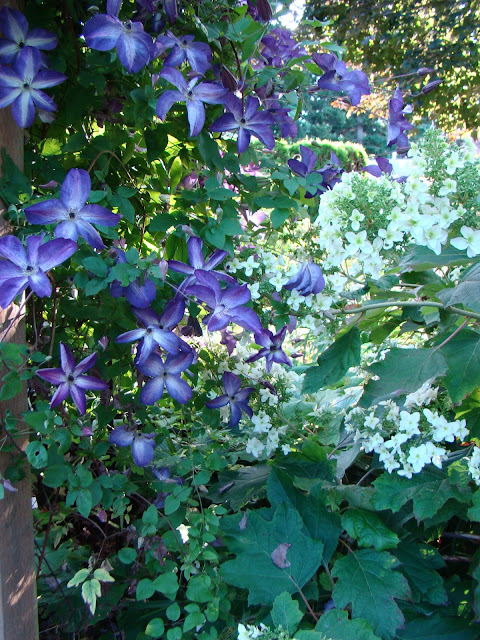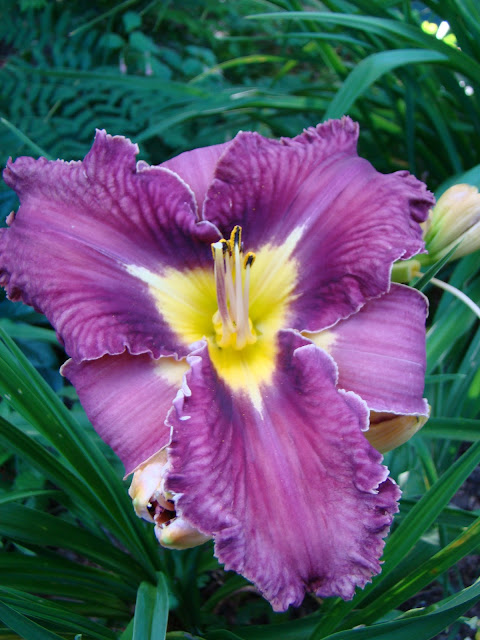Daylilies have been a part of my life as far back as I can remember. My mother brought starts for her garden whenever we moved from one place to another and when I headed out into the world on my own, I did the same thing. As my youthful enthusiasm increased, I added many more varieties and when I reached middle age, I had accumulated quite a collection. Now I am doing just the opposite - reducing those numbers.
The tall tawny orange daylily commonly referred to as the "ditch lily" and the short very early and very fragrant "lemon lily" were always part of my mother's gardens as we moved to new homes during my childhood. Daylilies aren't really lilies, but their familiar name is easy to understand from the shape of their blossoms and the fact that each flower only lasts for one day. Their botanical name is Hemerocallis and they are not a bulb, but an herbaceous perennial plant. The familiar tawny orange one is H. fulva and the lemon scented yellow one is H. flava. Both are species plants that probably originated in China. Some of the beautiful modern hybrids that we see in gardens today are their descendants.

Species plants were banished from my garden years ago because they tend to wander around sending underground stems out quite a distance from the main plant. They will continue to create cloned babies on these stems until something or someone stops them from spreading. That means that without a significant amount of intervention by me, other plants in the garden would be invaded and over time, completely choked out by the species daylilies.

Modern hybrids have been bred to behave more politely and remain in clumps that slowly increase at their perimeter over time. Flower colors, shapes, and sizes have been completely transformed over many years and today's cultivated forms are spectacular in the garden. At the height of my daylily addiction, I grew well over a thousand different named varieties. That number has been significantly reduced over the past few years as I make choices about what I can and cannot adequately care for as I age. I don't feel bad about letting go of those original poorly behaved plants - I still have daylilies - about three hundred of them now. Many of these plants are my own creations and have great sentimental value. But as time marches on, I suspect that I will have more choices to make.

Sometimes, it is difficult to decide which will go and which will stay. I've come to know them all so intimately. When the hot summer weather finally arrives, I greet each one as its first flower opens, lovingly visit each day to remove the spent blossoms, and say a reluctant goodbye as the final flower of the season fades at day's end. I have discovered that the decision is best made carefully and methodically by evaluating the entire plant's performance over the course of the bloom season. A spectacular flower won't add much to the garden if there are only a few blooms on the plant. When there is a beautiful one right there in front of me, I don't pay much attention to what the foliage looks like or how many more buds are waiting to open over the weeks ahead. Visiting every day is the only way to find negative traits behind the pretty faces. I note when the first flower on a plant opens and when the last one finishes. The plants with the longest periods of bloom and the nicest garden presence are the winners. Once the bloom season is over, if the foliage will bounce back and provide a pleasant grassy green backdrop for other late blooming plants in the garden, that's another plus. I mark the plants that will be removed and dig them when my memory of their pretty faces has faded a bit. It is easier that way.

As the total number of my daylily plants decreases, the percentage of worthy plants increases. I am removing some very good garden plants these days and feel fortunate that there are many young and enthusiastic gardeners ready to give them another chance in another garden. Seeing the delight on the faces of a new generation of daylily enthusiasts, I am transported for a brief period back in time - to when I was the recipient with the young garden. I am energized by the enthusiasm and excitement they project as they share plans for adding these daylilies to their new gardens. I hand them a daylily. I am given so much more in return. My heart is warm, my spirit happy, my soul content. What a gift!





























